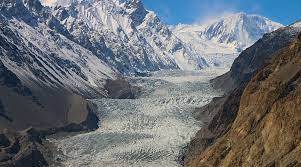
“This is the era of global boiling, not global warming” was a statement made by António Guterres the UN General Secretary and it truly reflects the issue of climate change. He said this with reference to continuous increases in the global average temperature that have led to the creation of problems like heat stocking, flash river floods, and melting of glaciers.
After the Polar Regions, the Hindu Kush, Karakoram and Himalayan regions are famous for their glaciers which is why this region is known as the third pole. As Gilgit Baltistan is located in this region and due to climate change, the region is experiencing Glacial Lake Outburst Floods (GLOFs).
On one side climate change results in the melting of glaciers while on the other conventional methods of glacier grafting can help in the re-birth of glaciers and it can be used as counter-mechanism for the glacier melting and water scarcity issue.
In Gilgit Baltistan, all glaciers are not formed naturally but local and indigenous glaciers grafting practices have also contributed to the genesis of glaciers in the region. One of them is “Gang Khswa”, it is a Balti word (local language) which means “nourishes with deep love and affection.
According to natives of Gilgit Baltistan, this practice was started many decades ago, but lack of literature and research studies was considered a myth and story, but now NGOs like the Aga Khan Rural Support Program (AKRSP) actively encourage it. The local communities of Gilgit Baltistan believe glaciers are classified into two groups, male and female glaciers. Male glaciers are black whereas female glaciers are white or bluish and when they breed new glaciers start to grow.
In this method, selection of breeding sites is the first step, where mountain areas having an altitude of 1200 feet are considered an ideal location. When people identify the male and female glaciers, they carry them to the selected site and add the female glacier over the male, and in the end, people celebrate with prayers and hymns just like a wedding ceremony.
In Gilgit Baltistan, the Aga Khan Rural Support Program (AKRSP) provides technical support to the local communities in this regard but, without efficient and proper government intervention this method cannot be replicated on large scale, so the government of Pakistan and Gilgit Baltistan should provide financial and technical support to the local communities of Gilgit Baltistan.
As this method involves different types of surveys such as identification of breeding sites and glaciers, transportation of glaciers, and digging of breeding sites, this is a high-cost activity that calls for financial support from the government.
While international organizations like UNDP have documented success of this method, the transfer of knowledge about this method to the new generation is important. Along with success stories, knowledge about identification of breeding sites and glaciers should be documented properly and part of the school-level curriculum.
Ice stupa is another mechanism of artificial glacier grafting. This method originated from Ladakh India and can be replicated in Pakistan and especially in Gilgit Baltistan. In the case of Gilgit Baltistan, this method has been successfully imitated in the village ‘Pari” of district Kharmang. The stream water is used for agricultural activities during the summer season and this water can be used for the formation of ice stupas in the winter season.
In this process, water is carried to high altitude areas having temperatures of -15 to -20ºC with the help of a pipe, and when the water discharges from the sprinkler of a pipe it reacts with cold water and gravity resulting in a mass of ice. The mass of ice is called an ice stupa. Later in the summer season when the temperature rises frozen water mass converts into liquid water and can be used for agricultural activities.
Like “Gang Khswa” ice stupas are also a counter mechanism for rapid climate change and glacier melting issues, but this also requires government intention to run on a large scale. Along with the government, international communities should facilitate such mechanisms instead of arranging climate change and climate financing conferences in air-conditioned halls because with the help of such interventions SDG goals like “Clean Water” and “Climate Actions” can be achieved.

